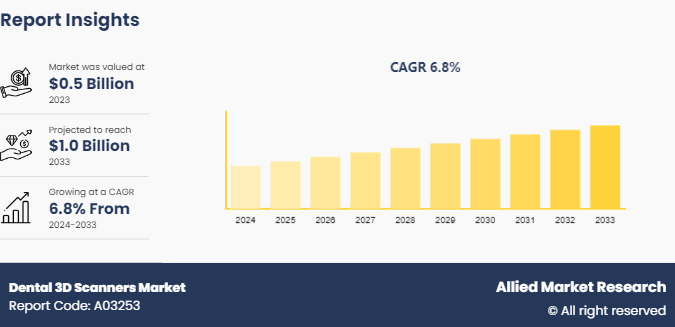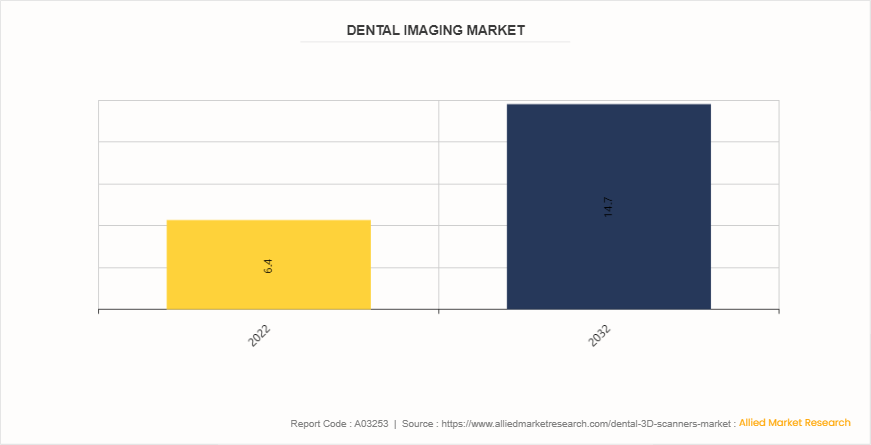Dental 3D Scanners Market Research, 2033
The global dental 3D scanners market size was valued at $0.5 billion in 2023, and is projected to reach $1.0 billion by 2033, growing at a CAGR of 6.8% from 2024 to 2033. The dental 3D scanners market is driven by increase in demand for accurate dental restorations, advancements in dental technology, growing prevalence of dental disorders, and the adoption of digital dentistry practices.

Market Introduction and Definition
Dental 3D scanners are advanced imaging devices used in dentistry to create highly accurate digital representations of patients' oral structures. These scanners utilize cutting-edge technology to capture detailed 3-dimensional images of the teeth, gums, and surrounding tissues with precision and efficiency. By eliminating the need for traditional dental impressions, dental 3D scanners streamline the diagnostic and treatment planning process, improving patient comfort and reducing chairside time. These scanners are essential tools for various dental applications, including restorative dentistry, orthodontics, prosthodontics, and implantology, enabling dentists to deliver tailored treatment solutions and achieve optimal clinical outcomes.
Key Takeaways
- The dental 3D scanners market share study covers 20 countries. The research includes a segment analysis of each country in terms of value for the projected period.
- More than 1, 500 product literatures, industry releases, annual reports, and other such documents of major dental 3D scanners industry participants along with authentic industry journals, trade associations' releases, and government websites have been reviewed for generating high-value industry insights.
- The study integrated high-quality data, professional opinions and analysis, and critical independent perspectives. The research approach is intended to provide a balanced view of global markets and to assist stakeholders in making educated decisions in order to achieve their most ambitious growth objectives.
Key Market Dynamics
The dental 3D scanners market size is driven by rise in technological advancements with continuous innovation enhancing the capabilities and performance of these scanners. Improved imaging resolution, faster scanning speeds, and enhanced software functionalities have made dental 3D scanners indispensable tools in modern dentistry. In addition, growing demand for digital solutions in dentistry, rising prevalence of dental disorders and the growing emphasis on preventive and cosmetic dental treatments further fuel the adoption of dental 3D scanners.
Moreover, the shift towards digital workflows and the integration of 3D scanning technology into CAD/CAM systems drive dental 3D scanners market growth by improving treatment planning, customization, and manufacturing of dental prosthetics and restorations. Furthermore, increasing investments in dental technology infrastructure and the expanding availability of 3D scanning services in dental clinics and laboratories contribute to growth during dental 3D scanners market forecast period.
However, the high initial costs associated with acquiring and implementing 3D advanced imaging systems pose a barrier to entry for many dental practices, especially smaller ones with limited financial resources which limits the market growth. Moreover, technological advancements in imaging technology and software algorithms present a significant opportunity for market expansion. Continuous improvements in scanner accuracy, speed, and ease of use enhance their utility across various dental applications, from restorative dentistry to orthodontics and implantology which provide a dental 3D scanners market opportunity.
Parent Market Overview
The dental imaging market serves as the parent market for the dental 3D scanners market, providing a comprehensive range of imaging solutions for dentistry. The global dental imaging market size was valued at $6.4 billion in 2022 and is projected to reach $14.7 billion by 2032, exhibiting a robust Compound Annual Growth Rate (CAGR) of 8.7% from 2023 to 2032. This growth is fueled by factors such as technological advancements, increasing prevalence of dental disorders, and rising demand for advanced diagnostic tools in dentistry.
Within the dental imaging market, dental 3D scanners play a crucial role in revolutionizing dental practices by providing highly accurate three-dimensional digital impressions of patients' oral structures. These scanners enable precise measurements, enhance treatment planning, and improve patient outcomes across various dental specialties. With growing adoption of digital dentistry solutions and rising awareness about the benefits of 3D imaging, the demand for dental 3D scanners is expected to continue rising, driving further growth within the broader dental imaging market.

Market Segmentation
The dental 3D scanners market is segmented into product, type, end user, and region. On the basis of the product, the market is categorized into desktop or laboratory dental 3D scanners, intraoral dental 3D scanners, hand-held dental 3D scanners, and cone beam computerized tomography (CBCT) . By type, the market is classified into 3D dental light scanner and 3D dental laser scanner. As per end user, the market is divided into hospitals, dental clinics, and others. Region wise, it is analyzed across North America, Europe, Asia-Pacific, and LAMEA.
Regional/Country Market Outlook
North America has significant dental 3D scanners market share during the forecast period owing to high adoption rates of advanced dental technologies, including dental 3D scanners. These regions benefit from well-established healthcare systems, reimbursement policies, and a large pool of skilled dental professionals, driving market growth. Moreover, the presence of key market players and ongoing research and development activities contribute to market expansion.
In emerging countries such as China, India, and Brazil, the market for dental 3D scanners is witnessing rapid growth fueled by factors such as increasing healthcare expenditure, rising dental tourism, and growing awareness about advanced dental treatments. These countries are investing in upgrading their healthcare infrastructure and adopting digital dentistry solutions to improve patient care and outcomes, creating opportunities for market players to expand their presence.
- According to 2022 National Dental Epidemiology Programme survey (UK) , it was reported that prevalence of children with enamel and/or dentinal decay was 29.3%. This significant prevalence led to the urgent need for advanced dental diagnostic tools, driving the growth of the 3D dental scanner market.
- According to 2023 article by World Health Organization (WHO) , it was reported that oral diseases affect nearly 3.5 billion people globally.
- According to 2023 article by National Library of Medicine, it was reported that overall prevalence of periodontal disease was 50% in southern part of India. This high prevalence drives the growth of the 3D dental scanner market in India by highlighting the critical need for precise and early diagnosis of periodontal conditions.
Competitive Landscape
The major players operating in the dental 3D scanners market include 3Shape A/S, Maestro 3D, Shining 3D, Envista Holdings Corporation, Densys Ltd, Dentsply Sirona, Planmeca Oy, Institut Straumann AG, 3M, and J. MORITA CORP. Other players in dental 3D scanners market include Owandy Radiology and so on.
Recent Key Strategies and Developments in Dental 3D Scanners Industry
- In February 2024, 3Shape expanded treatment opportunities for dental practices with TRIOS-meets-prime and 3Shape Automate. 3Shape will showcase its latest solutions for dental practices, including the award-winning TRIOS 5 intraoral scanner, 3Shape Unite platform, and value-bringing integrations.
- In December 2021, Carestream Dental LLC announced that they have entered into an agreement to sell Carestream Dental’s Scanning Technology business to Envista Holding Corporation (“Envista”) , a leading global dental products company for $600 million. The Scanning Technology business is composed of Carestream Dental’s intraoral scanner equipment (CS 3600, CS 3700, and CS 3800) and related software.
Key Benefits for Stakeholders
- This report provides a quantitative analysis of the market segments, current trends, estimations, and dynamics of the dental 3d scanners market analysis from 2024 to 2033 to identify the prevailing dental 3D scanners market opportunities.
- The market research is offered along with information related to key drivers, restraints, and opportunities.
- Porter's five forces analysis highlights the potency of buyers and suppliers to enable stakeholders make profit-oriented business decisions and strengthen their supplier-buyer network.
- In-depth analysis of the dental 3d scanners market segmentation assists to determine the prevailing market opportunities.
- Major countries in each region are mapped according to their revenue contribution to the global market.
- Market player positioning facilitates benchmarking and provides a clear understanding of the present position of the market players.
- The report includes the analysis of the regional as well as global dental 3d scanners market trends, key players, market segments, application areas, and market growth strategies.
Dental 3D Scanners Market Report Highlights
| Aspects | Details |
| Market Size By 2033 | USD 1.0 Billion |
| Growth Rate | CAGR of 6.8% |
| Forecast period | 2024 - 2033 |
| Report Pages | 228 |
| By Product |
|
| By Type |
|
| By End User |
|
| By Region |
|
| Key Market Players | Institut Straumann AG, Planmeca Oy, Shining 3D, J. MORITA CORP, 3M, Densys Ltd, 3Shape A/S, Dentsply Sirona, Maestro 3D, Envista Holdings Corporation |
The total market value of dental 3D scanners market is $0.5 billion in 2023.
The market value of dental 3D scanners market in 2033 is $1.0 billion.
The forecast period for dental 3D scanners market is 2024 to 2033.
The base year is 2023 in dental 3D scanners market.
Upcoming trends in the global dental 3D scanners market include enhanced integration with artificial intelligence for automation and precision, increased portability and affordability of devices, expanding applications in orthodontics and implantology, and the rise of intraoral scanning for chairside dentistry.
The leading application of the dental 3D scanners market is in restorative dentistry, particularly for creating precise and customized dental prosthetics such as crowns, bridges, and veneers.
North America is accounted for the largest market share in 2023 owing to advanced healthcare infrastructure, high adoption rates of digital technologies in dentistry, and a strong presence of key market players.
Dental 3D scanners are advanced imaging devices used in dentistry to create detailed three-dimensional models of dental structures such as teeth, gums, and jawbones.
Loading Table Of Content...



